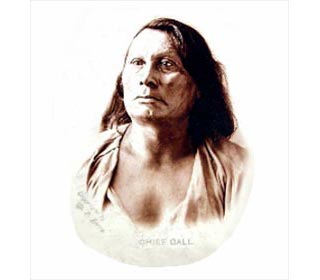The following fact sheet contains interesting facts, background history and information about the life of Gall and the events in history that led to his fame as a great Native American Indian leader. Fast Facts about Gall - Tribe: Sioux
- Clan: Hunkpapa Sioux
- Lifespan of Gall: c. 1840 - 1894
- Place of Birth: Near the Moreau River in South Dakota
- Date of Birth: c. 1840
- Date of Death: December 5, 1894
- Place of Death: Wakpala, South Dakota
- Native Indian Allies: Cheyenne
- Native Indian Enemies: Crow and Pawnee
- Famous Battles: Battle of the Little Bighorn
The Early Life of Gall
Gall was born around the 1840s near the Moreau River in South Dakota. Unfortunately, there were no reports about who his parents were. All that is known is he was an orphan growing up. In addition, as he was being groomed into a full fledged warrior, he also received several names. For example, the name Gall was given to him because when he was still a child, he tried to eat the gallbladder of an animal when he was out for the hunt and was very hungry. He was also named Matohinsa when he was growing up. This name meant Bear Shedding His Hair. His most popular name however was Pizi. Gall and Red Cloud
Gall grew up under the Lakota tribe which was led by Red Cloud, and under his guidance, Gall was able to fight many epic battles during Red Cloud's attempts to hold the Powder River country for the northern tribes. This changed however when Red Cloud signed the treaty of 1868. Gall was one of those who were against the treaty and did not sign the document. As a result, he left the tribe who was under the chieftainship of Red Cloud. As a result, Sitting Bull adopted him into their tribe and from Lakota, Gall became a Dakota. Gall and Sitting Bull
Sitting Bull treated Gall as a brother and appointed him the military chief of the Dakota tribe which was under his leadership. Sitting Bull had confidence in Gall's abilities as a great planner and strategist. Gall was able to immediately seize upon any advantage and became the mainstay of Sitting Bull's war council. He consistently upheld his people's right to their buffalo plains and believed that they should hold the government strictly to its agreements with them. Gall - The Battle of Little Big Horn
In the summer of 1876 the Native American Indians prepared for their biggest conflict with the US army. The trail to the Battle of the Big Horn began for Chief Gall when General George Custer sent Major Marcus Reno to attack his encampment along the Little Big Horn. The unprovoked attack on Chief Gallís village on June 25, 1876 resulted in the deaths of several members of Chief Gallís family. Gall went on to avenge the deaths and joined the forces of Sitting Bull. On 26 June 1876 the Battle of the Little Bighorn took place. The combined force of Native American Indians rode to attack General George Custer killing all of his 231 men including General Custer. The Battle of Little Bighorn became known as the greatest victory of the Native Americans against the U.S. soldiers. Gall flees to Canada
The stunned and angry reaction to the US defeat at the Battle of Little Bighorn prompted a massive outcry and the US government flooded the area with troops, forcing the Native American Indians to surrender or flee. Gall and Sitting Bull fled to Canada, but after five years of exile, he quarreled with his old friend and returned to the United States. Gall Surrenders
Gall surrendered on January 3, 1881. Tired of fighting and living in exile Gall turned his back on the past and adjust to the new inevitable way of life. He settled to become a farmer, supported schools for Sioux children, was appointed as judge for the Court of Indian Affair, opposed the Ghost Dance movement, and accepted the treaty of 1889. Gall was eventually regarded with high esteem among many Americans who admired his courage, wisdom and honesty. He died at Wakpala, South Dakota, December 5, 1894. He was 54 years old. The Story of Gall
For additional facts and information refer to the legend and the Story of Gall. | 